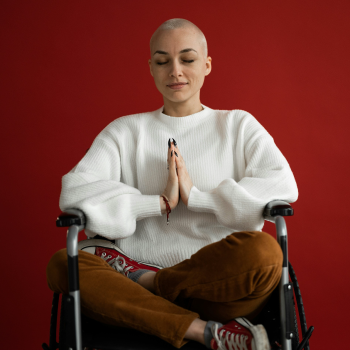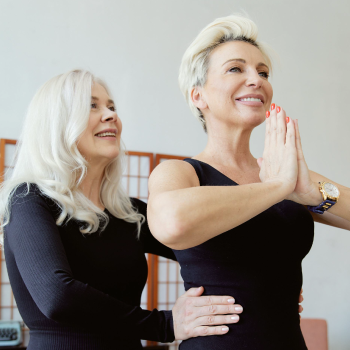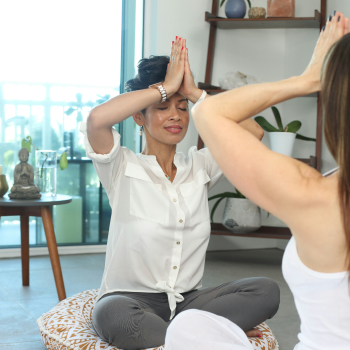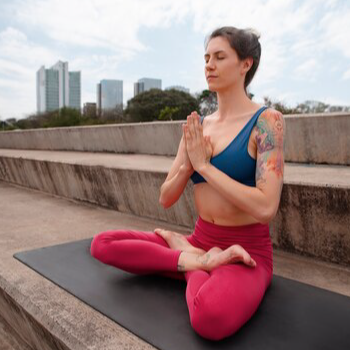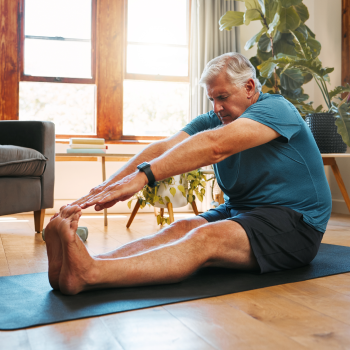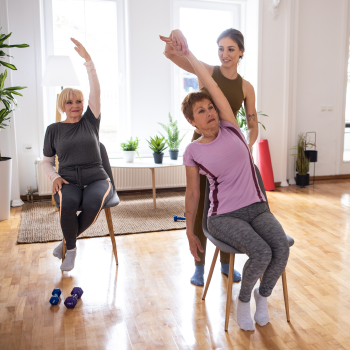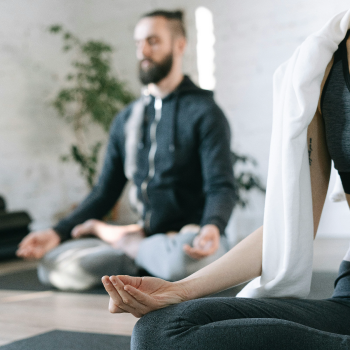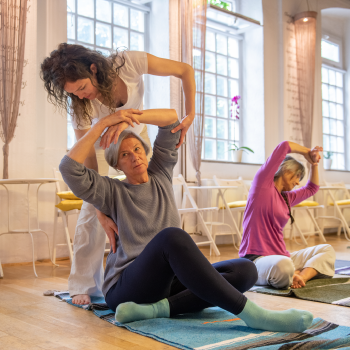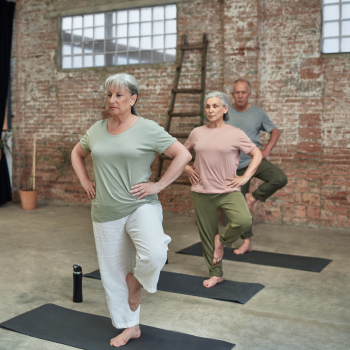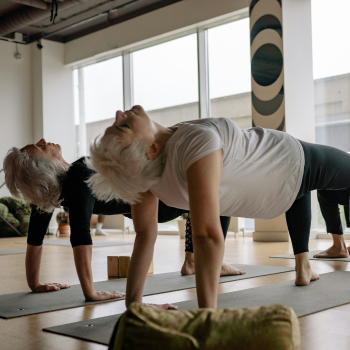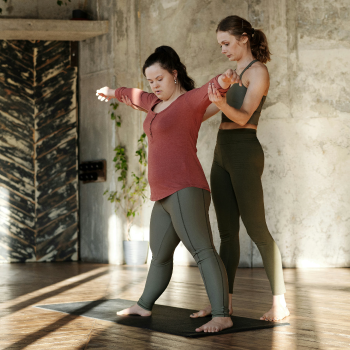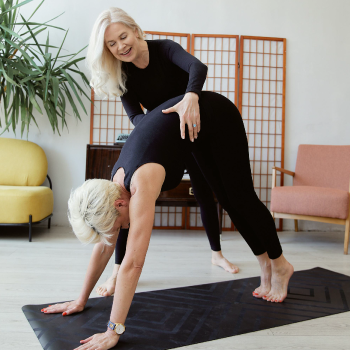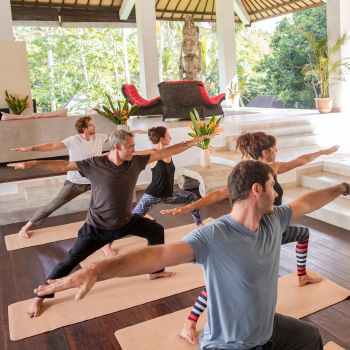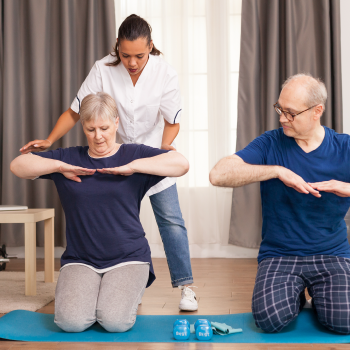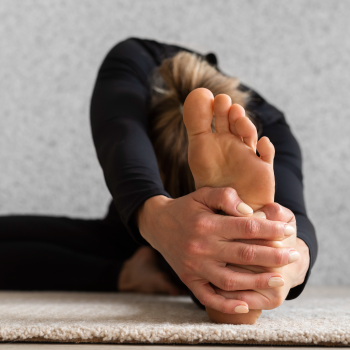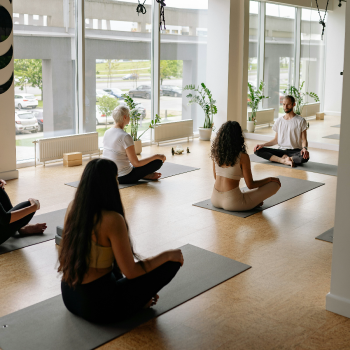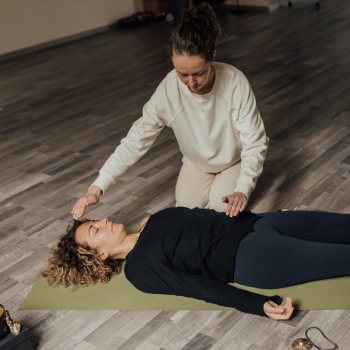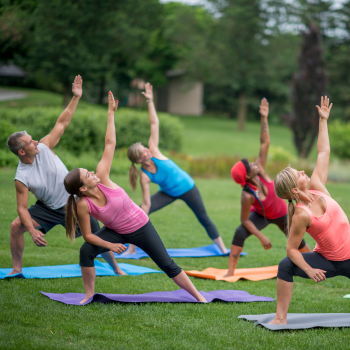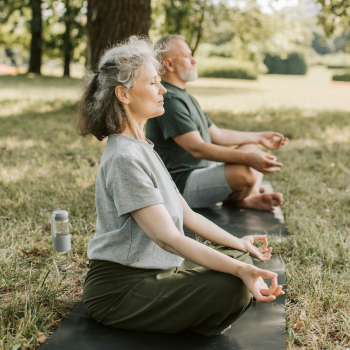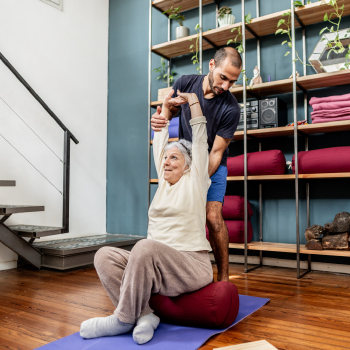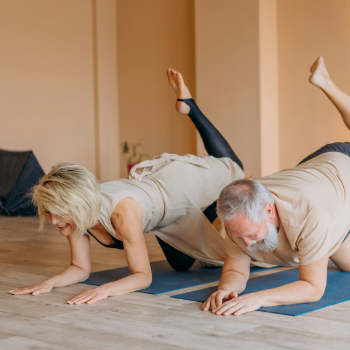Introduction
Have you ever felt like your body was a stranger to you? For many trauma survivors, this disconnection is all too real. But there's hope on the horizon, and it comes in an unexpected form: yoga. Not just any yoga, though. We're talking about a special approach called trauma-informed yoga. Let's dive into this gentle yet powerful practice that's changing lives, one breath at a time.
What is Trauma Informed Yoga?
Imagine a yoga class where nobody tells you to "push through the pain" or twist yourself into a pretzel. Sounds nice, right? That's the essence of trauma-informed yoga. It's not about nailing the perfect pose or competing with the bendy person next to you. Instead, it's all about creating a safe space where you can reconnect with your body at your own pace.
Sarah, a seasoned yoga therapist, puts it beautifully: "Trauma-informed yoga isn't about rehashing old wounds. It's about tuning into your body and letting go of the stuff you've been carrying around for too long."
But what exactly makes yoga "trauma-informed"? Let's break it down:
- Safety First: The physical and emotional safety of participants is the top priority.
- Choice and Control: You're always in charge of your practice. No forced poses or adjustments here.
- Non-Competitive: There's no "right" way to do things. Your journey is unique to you.
- Present-Moment Focus: We emphasize being in the now, not dwelling on the past or worrying about the future.
- Empowerment: The goal is to help you feel strong, capable, and in control of your body and mind.
What is Trauma?
Before getting deeper into trauma-informed yoga, let’s talk about trauma and trauma isn't just "all in your head." It leaves real, physical imprints on your body. Maybe you've noticed how stress makes your shoulders creep up to your ears, or how anxiety can make your heart race. These are just a few ways trauma can show up in your body.
For some folks, trauma turns the volume up on everything. Sounds seem louder, touches feel more intense, and relaxation feels like a distant dream. Others might feel numb, like they're watching life through a foggy window. Trauma-informed yoga helps address these issues by teaching you to be present in your body without judgment.
The Body Keeps the Score
You might have heard of the book "The Body Keeps the Score" by Dr. Bessel van der Kolk. If you haven't, it's a game-changer in understanding how trauma affects our bodies. Dr. van der Kolk explains that trauma isn't just stored in our memories – it's held in our muscles, our nervous system, even our digestive tract.
This is why sometimes talk therapy alone isn't enough. We need approaches that involve the body too. That's where trauma-informed yoga comes in. It's like a bridge between your mind and body, helping you reconnect and heal on a deeper level.
Common Physical Symptoms of Trauma
Let's talk about some common ways trauma might show up in your body:
- Chronic pain or tension, especially in the neck, shoulders, or back
- Digestive issues like IBS or frequent stomach aches
- Sleep problems, including insomnia or nightmares
- Fatigue or low energy
- Hypervigilance (always feeling on edge)
- Difficulty concentrating or brain fog
Sound familiar? You're not alone. These symptoms are your body's way of trying to protect you. But with trauma-informed yoga, we can start to send the message that it's okay to relax and feel safe again.
How Trauma-informed Yoga differs from Traditional Yoga?
If you've tried a regular yoga class and felt overwhelmed, you're not alone. Traditional yoga can sometimes be a bit much for trauma survivors. Picture this: you're in a crowded room, the instructor is telling you to close your eyes, and suddenly you feel exposed and vulnerable. Not exactly relaxing, is it?
Trauma-informed yoga flips the script. Here, you're in charge. Don't want to close your eyes? No problem. You can keep them open or softly gaze at a spot on the floor. The teacher won't come around and adjust your pose without asking, and there's no pressure to do anything that doesn't feel right for you.
Key Differences Between Traditional and Trauma-Informed Yoga
Let's break down some key differences:
- Language: In traditional yoga, you might hear commands like "Put your foot here" or "Stretch deeper." In trauma-informed yoga, it's all about invitations. "If it feels okay, you might try..." or "Notice how it feels to..."
- Choice: Traditional classes often have a set sequence. Trauma-informed classes offer options and encourage you to do what feels right for your body.
- Touch: Many traditional yoga teachers use hands-on adjustments. In trauma-informed yoga, touch is either avoided or only used with explicit permission.
- Environment: Trauma-informed classes pay extra attention to lighting, sound, and the overall feel of the space to create a sense of safety.
- Pace: The pace is often slower in trauma-informed yoga, with more time to settle into poses and check in with how you're feeling.
- Focus: While traditional yoga might emphasize perfecting poses, trauma-informed yoga is all about noticing sensations and building a relationship with your body
Does Trauma-Informed Yoga Really Work?
If you're skeptical about whether yoga can really help with trauma, you're not alone. But here's the thing: science is starting to back it up. One study looked at 64 women with chronic, treatment-resistant PTSD. After practicing trauma-informed yoga, more than half of them no longer met the criteria for PTSD. That's pretty impressive, especially compared to the control group, where only 21% saw similar improvement.
What's happening here? It seems that by reconnecting with our bodies in a safe, controlled way, we can actually rewire some of the patterns that trauma has etched into our brains and nervous systems. It's not a magic cure, but for many people, it's a powerful tool in their healing toolkit.
The Neuroscience of Trauma and Yoga
Let's get a bit nerdy for a moment (in a fun way, I promise!). Trauma can actually change the structure and function of our brains. It can shrink the hippocampus (important for memory) and amp up the amygdala (our brain's alarm system).
But here's the cool part: yoga can help reverse some of these changes. Studies have shown that regular yoga practice can:
- Increase the size of the hippocampus
- Reduce activity in the amygdala
- Strengthen the prefrontal cortex (our brain's "wise leader")
- Boost production of GABA, a neurotransmitter that helps us feel calm
In other words, yoga isn't just making you feel better in the moment – it's actually helping to rewire your brain for long-term healing and resilience.
Benefits of Trauma-Informed Yoga
So, what can you expect if you give trauma-informed yoga a try? Well, everyone's journey is different, but here are some common benefits:
- Better sleep (goodbye, 3 AM anxiety spirals!)
- Reduced anxiety and depression
- Improved body awareness (aka actually feeling at home in your own skin)
- Greater emotional resilience (because life likes to throw curveballs)
- A calmer nervous system (less fight-or-flight, more rest-and-digest)
One of the coolest things about trauma-informed yoga is how it teaches you to be present with your body's sensations without getting overwhelmed. It's like building a friendship with yourself, one gentle stretch at a time.
Real Stories of Transformation
Let's hear from some folks who've experienced the benefits of trauma-informed yoga firsthand:
Sarah, 32: "After my car accident, I was constantly on edge. Trauma-informed yoga helped me feel safe in my body again. Now, when I start to feel anxious, I know how to use my breath to calm down."
Mike, 45: "I was skeptical at first. As a veteran, I thought yoga was just for flexible people. But trauma-informed yoga has helped me sleep better than I have in years. It's become an essential part of managing my PTSD."
Aisha, 28: "Childhood trauma left me feeling disconnected from my body. Trauma-informed yoga has been like a gentle guide, helping me reconnect and feel whole again. It's been life-changing."
Trauma-Informed Yoga Poses
While trauma-informed yoga is more about the approach than specific poses, there are some asanas (yoga poses) that are often used for their grounding and calming effects. Remember, in trauma-informed yoga, these poses are always optional and can be modified to suit your needs.
- Mountain Pose: Helps you feel grounded and centered.
- Child's Pose: A restful pose that can help you feel safe and protected.
- Warrior II: Builds strength and confidence.
- Tree Pose: Improves balance and focus.
- Legs-Up-the-Wall Pose: A restorative pose that calms the nervous system.
The key is not perfecting these poses, but noticing how they make you feel. Does a pose help you feel strong? Calm? Safe? That's what we're after in trauma-informed yoga.
Mindful Breathing in Trauma-Informed Yoga
Ever notice how your breath changes when you're stressed? It might get shallow and quick, or maybe you find yourself holding your breath without realizing it. In trauma-informed yoga, we pay special attention to the breath. It's like a secret superpower for calming your nervous system.
For those dealing with anxiety, we might focus on longer exhales to help you feel more grounded. Feeling a bit low? We've got breathing techniques to help boost your energy. The best part? You can use these breathing tricks anytime, anywhere – not just on the yoga mat.
Simple Breathing Techniques to Try
Here are a few breathing exercises you can try right now:
- Box Breathing: Inhale for 4 counts, hold for 4, exhale for 4, hold for 4. Repeat.
- 4-7-8 Breath: Inhale for 4, hold for 7, exhale for 8. Great for calming anxiety.
- Alternate Nostril Breathing: Use your thumb and ring finger to alternate closing one nostril at a time as you breathe.
Remember, there's no "perfect" way to breathe. The goal is to find what feels comfortable and soothing for you.
Role of the Trauma-Informed Yoga Teacher
A skilled trauma-informed yoga teacher is like a compassionate guide on your healing journey. They're not there to "fix" you or push you into uncomfortable territory. Instead, their role is to create a safe container where you can explore and reconnect with your body at your own pace.
Here's what you can expect from a good trauma-informed yoga teacher:
- They'll ask for your consent before any hands-on adjustments.
- They'll offer choices and alternatives for every pose.
- They use inclusive, non-judgmental language.
- They create a predictable, consistent class structure.
- They're trained in recognizing and responding to trauma responses.
Remember, a good teacher is there to support you, not to be an authority figure. If something doesn't feel right, it's okay to speak up or opt out.
Integrating Trauma-Informed Yoga into Daily Life
The beauty of trauma-informed yoga is that its principles can extend far beyond your yoga practice. Here are some ways to bring that mindful, compassionate approach into your everyday life:
- Body Scans: Take a few moments each day to check in with your body. Notice any areas of tension or discomfort without trying to change them.
- Mindful Breathing: Use those breathing techniques we talked about earlier during stressful moments in your day.
- Grounding Exercises: When you're feeling overwhelmed, try focusing on the sensation of your feet on the ground or the texture of an object in your hand.
- Self-Compassion: Treat yourself with the same kindness and understanding that a trauma-informed yoga teacher would offer.
- Boundaries: Just like in a trauma-informed yoga class, it's okay to say no or to ask for what you need in your daily life.
By bringing these practices into your daily routine, you're reinforcing the healing work you do on the mat.
Ready to Give It a Try? Here's How to Get Started with Trauma-Informed Yoga
If you're thinking, "This sounds great, but where do I even begin?" – don't worry, we've got you covered. The key is finding the right instructor. Not all yoga teachers are trained in trauma-informed practices, so it's worth doing a bit of homework.
Look for instructors who have specific training in trauma-sensitive yoga. My Yoga Network is a great resource for finding certified yoga therapists who know their stuff when it comes to trauma-informed practices. Don't be shy about reaching out to potential instructors with questions. A good trauma-informed yoga teacher will be happy to chat with you about their approach and help you feel comfortable before you even step on the mat.
Tips for Your First Trauma-Informed Yoga Class
Feeling a bit nervous about trying a class? That's totally normal. Here are some tips to help you feel more at ease:
- Start small: Look for a small class size or even consider a one-on-one session to start.
- Bring a friend: Having a trusted person with you can help you feel more comfortable.
- Communicate with the teacher: Let them know it's your first time and share any concerns you have.
- Set an intention: Before class, decide what you want to get out of the experience. It could be as simple as "I will listen to my body."
- Have an exit strategy: Know that it's okay to leave the class at any time if you're feeling overwhelmed.
Be patient with yourself: Healing takes time. There's no need to rush or push yourself too hard.
Complimentary Therapies for Trauma Recovery
While trauma-informed yoga can be a powerful tool on its own, many people find it helpful to combine it with other healing practices. Here are some complementary approaches that can work well alongside trauma-informed yoga:
- Mindfulness Meditation: This can help deepen the mind-body connection you're building in yoga.
- Somatic Experiencing: Another body-based approach to healing trauma that can complement yoga nicely.
- Art Therapy: Expressing yourself creatively can be a great way to process emotions that come up during yoga.
- Talk Therapy: A therapist can help you integrate insights and experiences from your yoga practice.
- Nature Therapy: Spending time outdoors can have a grounding effect similar to yoga.
Remember, healing isn't one-size-fits-all. It's okay to explore different approaches and find what works best for you.
Wrapping It Up: Your Journey to Healing
Trauma-informed yoga isn't about perfection or pushing yourself to the limit. It's about creating a compassionate space where you can reconnect with your body and start to feel safe again. Whether you're dealing with PTSD, anxiety, or just feeling a bit disconnected from yourself, this gentle approach to yoga might be just what you need.
Remember, healing isn't a straight line, and there's no one-size-fits-all solution. But with trauma-informed yoga, you've got a powerful tool in your healing toolkit. So why not give it a try? Your mind and body might just thank you for it.
Ready to start your journey? Check out My Yoga Network to find certified trauma-informed yoga instructors near you. Your path to healing and reconnection is just a breath away.
And remember, every step you take towards healing, no matter how small, is a victory. Be patient with yourself, celebrate your progress, and know that you're not alone on this journey. Here's to rediscovering the strength and resilience that's been within you all along. Namaste.
References
Written By: Ram on 09-07-2024

